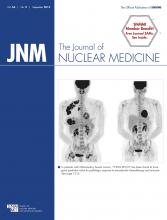TO THE EDITOR: The development and application of ligands for PET imaging of Alzheimer disease (AD) has evolved into an important tool for the clinical diagnosis of AD. Among the promising ligands, Pittsburgh compound B (PiB), developed by Mathis et al. (1) and Klunk et al. (2), is one well-known example. In cooperation with Långström and his group in Uppsala, PiB was labeled with 11C and applied clinically (3). The tracer was soon used in many other academic centers and initiated such continuous interest that 3 compounds—18F-florbetapir, 18F-flutemetamol, and 18F-florbetaben—obtained approval by the Food and Drug Administration for regular clinical application.
Kobylecki et al. evaluated 18F-florbetapir in patients with AD and frontotemporal dementia and in healthy controls (4). When PET images were masked to clinical data and regional analysis, trained interpreters had positive results in 80% of AD patients but also in 25% of patients with frontotemporal dementia and 10% of healthy controls. If all clinical information and sources of error, such as atrophy, increased white matter accumulation, or movement during registration, were taken into consideration, the interpreters could discriminate frontotemporal dementia and AD. In his perspective, Frey discussed the results in a comprehensive and conclusive way (5). In any case, increased training of interpreters remains highly advisable, but alternatively, PET imaging of Aβ plaques may be improved by a variation of protocols. Therefore, I am writing this letter to draw attention to two promising approaches to both early diagnosis of AD and highly accurate PET assays.
The approach to early diagnosis of AD is to extend PET imaging to tracer binding in plaques within muscles. PET imaging of such plaques was successfully demonstrated by Maetzler et al. with 11C-PiB (6). In general, the existence of plaques in muscles is known as inclusion body myositis (IBM), and the PET findings indicated amyloid β deposition. Recently, in a comprehensive experimental study, Schuh et al. showed that amyloid plaque formation follows the same mechanism in muscle as in brain (7). Moreover, amyloid precursor proteins were found as observed in the brain. The work of Schuh et al. brings up an interesting approach to the early diagnosis of AD or at least widens the window for follow-up studies during disease progression.
The approach to highly accurate PET assays is pharmacokinetic analysis of PET data, because the metabolic assessment is performed in a precisely defined way. If the data are analyzed by a 3-compartment model (also known as the 2-tissue-compartment model), the rates of plaque binding (k3) and release (k4) can be calculated. Independently of binding rates, tracer delivery from the blood is determined by K1. In AD, blood flow is known to decrease with disease progression. Therefore, increased tracer binding to plaques may be obscured by decreased tracer delivery to the region of interest. Even if reference regions are used, these regions are not ensured to be good controls.
In any case, during disease progression, alterations in blood flow and metabolism must be assumed to proceed differently from and independently of each other. In a longitudinal study with 2 mouse models, Maier et al. impressively showed blood flow to decrease drastically in late phases of the disease (8). Tracer binding, however, remained at a plateau, indicating a stable disease phase. Alternatively, pharmacokinetic analysis may show increased tracer release (k4), which compensates for higher uptake rates (k3). Pharmacokinetic analysis directly reveals the metabolic pathways ongoing with AD and allows consequent discrimination of the various velocity constants. In any case, the prerequisite is dynamic PET registration, for which all PET systems are sensitive and fast enough. Using appropriate subroutines, pharmacokinetic calculations can be performed to create parametric images.
Pharmacokinetic modeling is well proven in PET imaging but is not the focus of the community and, at least, is not thought to be suited to routine PET applications. Shen et al. (9) and Palner et al. (10) recently presented a striking illustration of the possible key role of pharmacokinetic calculations. In the case of apoptosis resulting from chemotherapy, they obtained PET results that were highly significant but values that remained small, below 3% injected dose per gram. However, pharmacokinetic analysis revealed uptake rates (k3) that were 3-fold higher in apoptotic cells. Thus, the way to clinical translation is well paved.
In plaque imaging, sources of error include movement during PET registration, atrophy, and increased accumulation in white matter. Therefore, simultaneous registration by PET/MR imaging has already been proven particularly advantageous and opens a way to direct translation to clinical applications, as discussed by Wehrl et al. (11,12).
In summary, the extension of PET imaging to amyloid plaques in muscles to gain a broader view of AD progression, perhaps including early disease phases, seems promising. In addition, pharmacokinetic analysis of PET data may allow us to determine metabolic parameters that play a key role, particularly in follow-up studies of AD.
Footnotes
Published online Jul. 9, 2015.
- © 2015 by the Society of Nuclear Medicine and Molecular Imaging, Inc.







